After traveling through the beautiful trees of the Deciduous Forest, we are changing course. Better grab your coat and toque because the winters in this biome are long, dark and chilly!
The Tundra biome is found at the top of mountains (Alpine tundra) and just below the Arctic Circle (Arctic tundra). It is the coldest of all the biomes. In fact, for 6-10 months of the year, the temperature in the tundra is below 0°C. Despite experiencing less rain than most deserts, the tundra remains wet because these cold temperatures slow the rate of evaporation. This cold weather also means that there is a layer of ground, just below the surface, that is permanently frozen, called permafrost. Although temperatures warm up during the summer, the growing season is very short and the soil thaws only a few inches deep. This limits the biodiversity among plants, mainly growing mosses, grasses, shrubs and other resilient plants.
RED
Harlequin Duck (Histrionicus histrionicus)
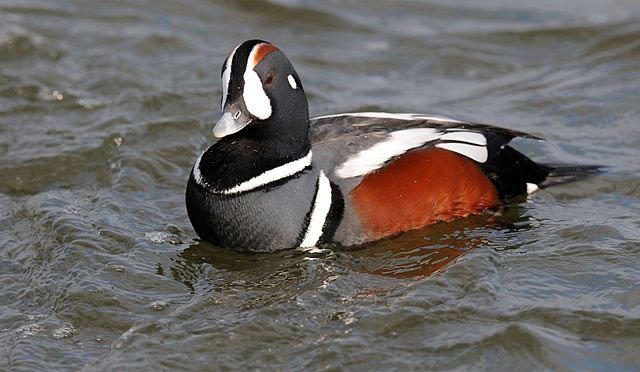
Details: Considered one of the most colourful sea ducks, the coats of males are dark blue and feature accents of white and chestnut. It is these colourful feathers, along with courtship dances, that females will use to select a mate. Females are not as colourful, usually a dusky brown, with whitish patches on the sides of their face.
My Hood: Along the Pacific and Atlantic coasts of North America. They also breed in Greenland and Iceland. The Harlequin duck winters along the coast of the Bering Sea Islands, Japan, Korea, China, California and from southern Labrador to Long island. During the spring and summer the Harlequin duck lives in freshwater habitats, but during the winter they head to the seas and rocky parts of the coast
How I fit in: Unlike most northern ducks, the Harlequin sets up their nests beside fast-flowing streams. The mother uses this stream to teach her young valuable life skills, like how to find food on their own. Living in very different environments throughout the seasons means their survival depends on lots of habitat protection! Development, the threat of oil spills, and human interference are some of the big threats to this species’ breeding and wintering grounds.
http://www.hww.ca/hww2.asp?id=47
http://www.eol.org/pages/1048979
ORANGE
Yellow-bellied marmot (Marmota flaviventris)
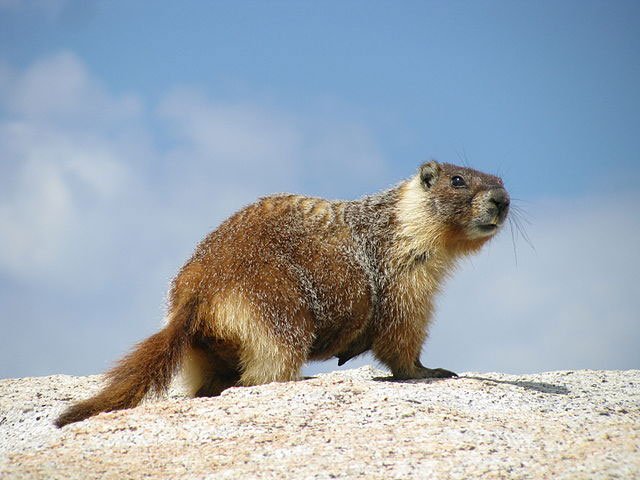
Details: Like most of their family, Yellow-bellied marmots have thick, coarse fur. Males are heavier (2.95-5.22kg) and longer (490-700mm) than females. However, what females lack in size, they make up for in their parenting. While males have no hand in raising young, females share the responsibility with other mothers to ensure their offspring are reared properly.
My Hood: This marmot lives among the mountains of Southern BC and Alberta all the way down to Southwestern US. Although they normally live at elevations of 2000m, they can be found up to 4,100m in the Rocky Mountains. That’s over 4X the height of the world’s tallest skyscraper.
How I fit in: The Alpine tundra can get pretty cold and in September, yellow-bellied Marmots retire to their warm burrows to start hibernating. By the time May rolls around, the weather warms up and the marmots emerge from their dens. From May to September, they have their young and spend most of their time bulking up for the next winter’s sleep.
http://www.eol.org/pages/327985
YELLOW
Arctic Bumblebee (Bombus polaris)
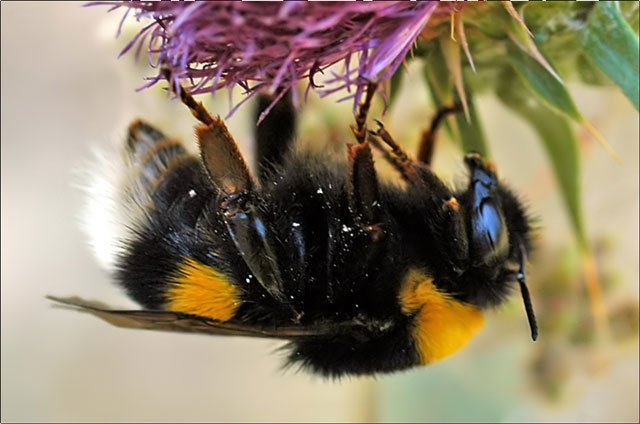
Details: Bombus polaris has the distinct look of a common bumblebee. Along with Bombus hyperboreus, they are the only species of bumblebees found in the high north. Bombus polaris is the smaller and more social of the two species.
My Hood: These bees are found around the Arctic Circle. They can even be found on Ellesmere Island and they are one of the only social insects to live that far north.
How I fit in: All bees are cold-blooded, meaning their body temperature is dependent on the air temperature around them. As a result many bees can’t function in the cold. However, bees like Bombus polaris have ways to keep from freezing. They generate heat by twitching their flying muscles and they have also developed dense hair on their bodies, which slows heat loss. They keep their body temperature at 20-30°C, even when the air around them is below freezing. Since there are so few insects found in the north, they play a very important role in the pollination of Arctic plants.
http://www.nps.gov/akso/ParkWise/Students/ReferenceLibrary/BELA/ArcticAdaptations.htm
http://www.geog.ucsb.edu/events/department-news/803/the-plight-of-the-bumblebee/
http://www.arctic.uoguelph.ca/cpl/organisms/inverts/Close_ups/terrestrial/Hymen_usurper.htm
GREEN
Northern Grasshopper (Melanoplus borealis)
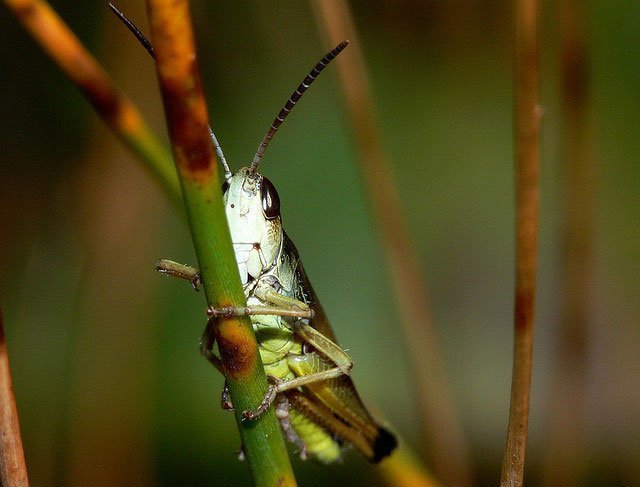
Details: This flying grasshopper has a dark body (black, brown, tan or green) accented with a light crescent on its head. Females are the larger of the two genders, reaching 392mg, while males grow to be about 231mg.
My Hood: In Arctic tundra, bogs and mountain meadows of Canada and Northern USA.
How I fit in: The sun is very important to these grasshoppers. To fight the cold temperatures, they bask in the sun until they have warmed up enough to search for food. They eat mostly forbs (like dandelions), grasses and dead insects, but have been known to cause damage to plants if their population is too high. In the evening, they bask in the sun one more time before it sets and they return to their shelters for the night.
http://www.sidney.ars.usda.gov/grasshopper/ID_Tools/F_Sheets/northern.htm
http://www.entomology.ualberta.ca/searching_species_details.php?b=Orthoptera&c=7&s=38034
BLUE
Spring Gentian (Gentiana Verna)
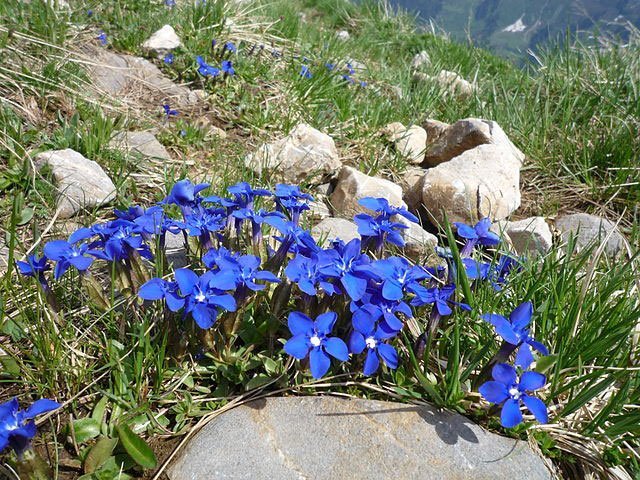
Details: The Spring Gentian is the smallest plant in its family. It can grow 7cm and produces five pointed starflowers that measure 15-30mm. These blue flowers are in bloom from April to June.
My Hood: Although they have been found on the hills of Europe, it is a rare occurrence. When they are spotted, they usually grow very close to limestone deposits and up to elevations of 3000m.
How I fit in: This plant loves the sun. The flowers warm themselves when the sun is shining, but close their petals when the sun disappears. The Spring Gentian also relies on bees for pollination. However, sometimes the bees will skip pollination and bite through the stem for a drink of its nectar.
http://www.northpennines.org.uk/getmedia.cfm?mediaid=12560
H. S. Pardoe Mountain Plants of the British Isles: An Introduction to our Native Arctic-Alpine Flora. Cardiff: National Museum of Wales, 1995: Page 24
Hilary Sharp Trekking and Climbing in the Western Alps. London: New Holland Publishers (UK) Ltd., 2002: Page 82
PURPLE
Purple Mountain Saxifrage (Saxifraga oppositifolia)
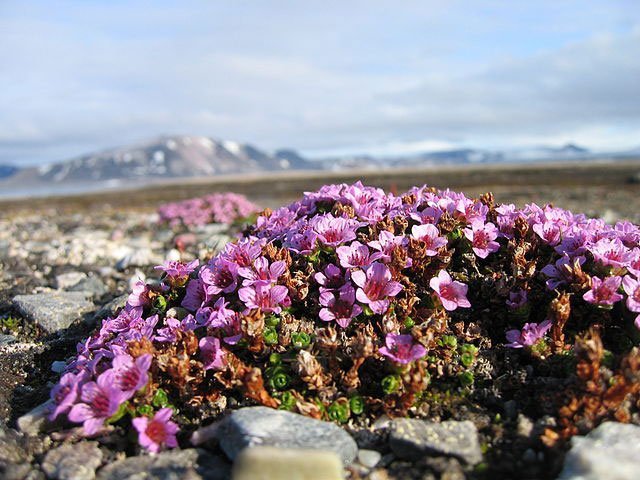
Details: This saxifrage grows brilliant purple flowers on densely packed leaves – so dense, in fact, that it may be mistaken for moss. The leaves are egg shaped and grow about 2-5mm. In certain areas, it can flower as early as March and is known to be fearless of snow. If you are ever hungry near a Purple Mountain Saxifrage, take a bite – this plant is edible.
My Hood: The purple mountain Saxifrage grows in Europe, Asia and parts of North America. They are found on mountains at elevations as high as 5600m and in the Arctic regions.
How I fit in: It is considered one of the hardiest of all the seed producing plants. They can grow where no other vascular plant can, like along cliff ledges and hilltops, due to the structure of their leaves.
http://www.eol.org/pages/583337
http://www.mun.ca/biology/delta/arcticf/_ca/www/sxsxop.htm
Anne Pratt The Flowering Plants and Ferns of Great Britain. London: Under the Direction of the Committee of General Literature and Education, 1855: Page 348-350
More splashes of colourful biomes are coming your way soon. In the meantime, find out what a biome is and the different types that can be found on Earth. Up next: the Taiga Forest!!
To find out more about the tundra biome check out these links:
http://earthobservatory.nasa.gov/Experiments/Biome/biotundra.php


the flowers are so beautiful
awesome
my favorite are the purple mountain saxifrage and the spring gentian
Those blue flowers are so pretty
the bumble bees look cool
cool
the purple saxifrage are edible?!
yes it’s edible. We use it to make honey
what dose purple saxifrage taste like?
Fun